Three times a week, Mike Owens and his running partner, Dixie, hit Rock Creek Park’s trails and log a few miles before work. Usually their jogs are enjoyable, but Dixie has one problem: She’s a terrible pacer.
“She stops to smell something, then sprints to catch up,” Owens says. “And she always wants to jump in Rock Creek for a swim.”
Dixie’s not your average runner. She’s a six-year-old black-Labrador mix that Owens adopted as a puppy. “I was looking for a dog that could be a running companion,” he says. “I was not interested in a little house dog.”
The duo typically runs five to ten miles but has gone as far as 15 while Owens trained for a half Ironman. He uses a six-foot elastic leash that wraps around his waist, keeping his hands free and providing Dixie extra room to move.
Not all dogs make for great jogging companions, says veterinarian Adam Jaffe of Montgomery Animal Hospital. While high-energy dogs such as terriers, retrievers, shepherds, and hounds can go for miles, dogs with short snouts—bulldogs and pugs especially—are not ideal runners. “Because they have smooshed faces and small nostrils, they can overheat quickly,” Jaffe says. Even boxers, known for their athleticism, have trouble breathing due to the size of their snouts.
A dog’s height and build can be a deal-breaker, too, says Sean Prichard, who owns a dog-fitness company called Pant & Wag that takes dogs running in Rock Creek Park, the National Arboretum, Theodore Roosevelt Island, and Fort Dupont Park. Prichard says short, long dogs such as corgis and dachshunds have difficulty running, while lean and muscular dogs bred for hunting can endure up to five to six hours of activity per day.
Some dogs are prone to joint problems such as arthritis, which running can exacerbate. Hip dysplasia, a condition that results in loose hip joints, commonly affects large breeds such as Great Danes. If your dog is subject to orthopedic issues or is older, Jaffe cautions to keep the mileage low and stick to grass or dirt trails.
Even good running dogs must be trained and shouldn’t go on long runs until they’re a year or older, Jaffe says: “You don’t go out for a ten-mile run right away. That’s like running a marathon tomorrow without any training.”
At the Washington Humane Society, dogs must be two years old before fully participating in the People & Animal Cardio Klub (PACK), an exercise group that takes the shelter’s dogs on three-mile runs throughout DC. “We wait until they’re two because their joints are very susceptible to injury before then,” says Alison Coates, the shelter’s behavior-and-training counselor. For young dogs, intersperse walking with jogging and build up mileage as they age.
The training period also teaches owners to spot warning signs that it’s time to stop. Mike Owens says of Dixie: “She loses energy and looks and acts tired—that means the run’s over.” It’s also important to make sure a water source is nearby in case the dog becomes overheated or exhausted.
Once owner and animal find their rhythm, running with a dog can be more fun and satisfying than doing so alone. Says Leigh Stapleton, a volunteer with PACK: “Like me, dogs use a run to channel their energy. I find it gratifying that we’re running for the same reason.”
More than once, joggers have stopped Stapleton in Rock Creek Park to ask about adopting a dog she’s running with: “They say, ‘I could run with that dog, too.’ You never have a bad run when you’re running with a dog.”
This article appears in the February 2014 issue of Washingtonian.



















